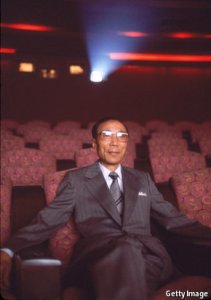Kung fu fight king
Sir Run Run Shaw made his mark on Hollywood and the wider world
Jan 11th 2014 | BEIJING | From the print edition
IF HE had made a film of his own life, Sir Run Run Shaw might have called it “The Last Mogul”. From a stylised opening scene in the late-Qing dynasty Shanghai of his childhood to his death in Hong Kong at the age of 106 on January 7th, it could have been a trademark production of Shaw Brothers, the studio that created the Hong Kong action-movie industry.
It would be full of action itself, as when he and his brothers buried $4m worth of gold and jewellery in Singapore during the second world war to protect it from the Japanese. Before the war they had produced films in South-East Asia, but in 1957 Sir Run Run moved to Hong Kong. There he built the studio that would produce hundreds of films—such as “The One-Armed Swordsman” and “Five Fingers of Death”—that began a global craze for martial arts.
A Shaw film would feature stars on strict contracts. One actor complained that working for Sir Run Run’s Hong Kong television company, TVB, was like putting an orange into a juicer: the juice belonged to TVB, and whatever remained belonged to you. Nevertheless, many went into the juicer and came out better for it—Chow Yun-fat, Tony Leung and Wong Kar-wai among them.
Bruce Lee, refusing to work under Shaw Brothers’ strict terms, achieved fame with a rival studio, but that too was started by a former Shaw associate. “Everybody owes a debt to the Shaw brothers and Run Run Shaw,” says Bey Logan, a Hong Kong film producer. Sir Run Run also helped produce some American films, such as “Blade Runner”.
“The Last Mogul” would also make money, because that is what his films did (he said movies that made money were his favourite kind). And then the proceeds would go to charity, just as Sir Run Run gave millions to good causes, increasingly in mainland China.
Perhaps his subtlest influence may have been to provide, at the height of Mao’s rule and beyond, an alternative vision of China to the world. For many, the Qing dynasty and Republican-era tableaux of Shaw Brothers films were the images that endured long after the Red Guards had gone.
Sir Run Run Shaw made his mark on Hollywood and the wider world
Jan 11th 2014 | BEIJING | From the print edition
IF HE had made a film of his own life, Sir Run Run Shaw might have called it “The Last Mogul”. From a stylised opening scene in the late-Qing dynasty Shanghai of his childhood to his death in Hong Kong at the age of 106 on January 7th, it could have been a trademark production of Shaw Brothers, the studio that created the Hong Kong action-movie industry.
It would be full of action itself, as when he and his brothers buried $4m worth of gold and jewellery in Singapore during the second world war to protect it from the Japanese. Before the war they had produced films in South-East Asia, but in 1957 Sir Run Run moved to Hong Kong. There he built the studio that would produce hundreds of films—such as “The One-Armed Swordsman” and “Five Fingers of Death”—that began a global craze for martial arts.
A Shaw film would feature stars on strict contracts. One actor complained that working for Sir Run Run’s Hong Kong television company, TVB, was like putting an orange into a juicer: the juice belonged to TVB, and whatever remained belonged to you. Nevertheless, many went into the juicer and came out better for it—Chow Yun-fat, Tony Leung and Wong Kar-wai among them.
Bruce Lee, refusing to work under Shaw Brothers’ strict terms, achieved fame with a rival studio, but that too was started by a former Shaw associate. “Everybody owes a debt to the Shaw brothers and Run Run Shaw,” says Bey Logan, a Hong Kong film producer. Sir Run Run also helped produce some American films, such as “Blade Runner”.
“The Last Mogul” would also make money, because that is what his films did (he said movies that made money were his favourite kind). And then the proceeds would go to charity, just as Sir Run Run gave millions to good causes, increasingly in mainland China.
Perhaps his subtlest influence may have been to provide, at the height of Mao’s rule and beyond, an alternative vision of China to the world. For many, the Qing dynasty and Republican-era tableaux of Shaw Brothers films were the images that endured long after the Red Guards had gone.
Attachments
-
30.4 KB Views: 1


